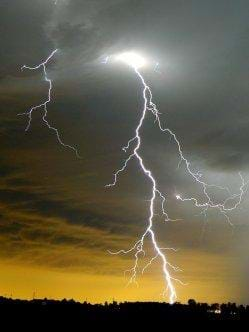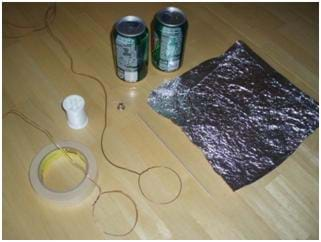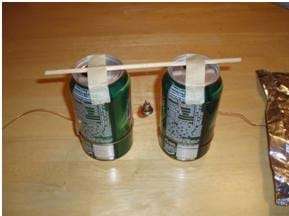Quick Look
Grade Level: 8 (6-8)
Time Required: 1 hours 30 minutes
(can be split into two 45-minute sessions)
Expendable Cost/Group: US $2.00
Group Size: 2
Activity Dependency:
Subject Areas: Earth and Space, Science and Technology
NGSS Performance Expectations:

| MS-ETS1-4 |

Summary
Students discuss the characteristics of storms, including the relationship of weather fronts and storms. Using everyday materials, they develop models of basic lightning detection systems (similar to a Benjamin Franklin design) and analyze their models to determine their effectiveness as community storm warning systems.Engineering Connection
Engineers design instruments to help predict and track weather fronts and storms, including weather radar and lightning strike indicators that provide early storm warnings to keep people safe. These instruments are used by meteorologists, electrical utilities, parks and recreation services, and pilots. Handheld lightning detectors are also used in sporting events, camping, hiking, sailing and golfing. Engineers also develop warning displays used by weather services to alert people to oncoming severe storms.
Learning Objectives
After this activity, students should be able to:
- Describe the characteristics of a thunderstorm.
- Describe a variety of ways that a lightning detection system is used.
- Develop and analyze a model lightning detection system.
Educational Standards
Each TeachEngineering lesson or activity is correlated to one or more K-12 science,
technology, engineering or math (STEM) educational standards.
All 100,000+ K-12 STEM standards covered in TeachEngineering are collected, maintained and packaged by the Achievement Standards Network (ASN),
a project of D2L (www.achievementstandards.org).
In the ASN, standards are hierarchically structured: first by source; e.g., by state; within source by type; e.g., science or mathematics;
within type by subtype, then by grade, etc.
Each TeachEngineering lesson or activity is correlated to one or more K-12 science, technology, engineering or math (STEM) educational standards.
All 100,000+ K-12 STEM standards covered in TeachEngineering are collected, maintained and packaged by the Achievement Standards Network (ASN), a project of D2L (www.achievementstandards.org).
In the ASN, standards are hierarchically structured: first by source; e.g., by state; within source by type; e.g., science or mathematics; within type by subtype, then by grade, etc.
NGSS: Next Generation Science Standards - Science
| NGSS Performance Expectation | ||
|---|---|---|
|
MS-ETS1-4. Develop a model to generate data for iterative testing and modification of a proposed object, tool, or process such that an optimal design can be achieved. (Grades 6 - 8) Do you agree with this alignment? |
||
| Click to view other curriculum aligned to this Performance Expectation | ||
| This activity focuses on the following Three Dimensional Learning aspects of NGSS: | ||
| Science & Engineering Practices | Disciplinary Core Ideas | Crosscutting Concepts |
| Develop a model to generate data to test ideas about designed systems, including those representing inputs and outputs. Alignment agreement: | Models of all kinds are important for testing solutions. Alignment agreement: The iterative process of testing the most promising solutions and modifying what is proposed on the basis of the test results leads to greater refinement and ultimately to an optimal solution.Alignment agreement: | |
International Technology and Engineering Educators Association - Technology
-
Explain how knowledge gained from other content areas affects the development of technological products and systems.
(Grades
6 -
8)
More Details
Do you agree with this alignment?
-
Develop innovative products and systems that solve problems and extend capabilities based on individual or collective needs and wants.
(Grades
6 -
8)
More Details
Do you agree with this alignment?
State Standards
Colorado - Science
-
Differentiate between basic and severe weather conditions, and develop an appropriate action plan for personal safety and the safety of others
(Grade
8)
More Details
Do you agree with this alignment?
-
Use models to develop and communicate a weather prediction
(Grade
8)
More Details
Do you agree with this alignment?
Materials List
Each group needs:

- 2 empty aluminum soda cans
- 1 8-inch wooden dowel
- 6 inches of thread
- masking tape
- 2 square feet of aluminum foil
- 2 pieces of copper wire, about 36 inches each (alligator clips also work)
- 1 small jingle bell (available at craft and fabric stores)
- Lightning Detector Testing and Analysis Worksheet, one per person
For the entire class to share:
- 1 metal chair or desk (to ground the model lightning detector)
- 1 television set (any size; must turn on; does not need to actually have a signal or be clear)
- (optional) extra bells, cans, foil, thread or other items for students to improve on their designs
Worksheets and Attachments
Visit [www.teachengineering.org/activities/view/cub_weather_lesson03_activity1] to print or download.Pre-Req Knowledge
Students should have some knowledge of weather fronts, as described in the associated lesson, Stormy Skies.
Introduction/Motivation
How do you know if a storm coming our way? Do you look at the skies for signs of changing weather, listen to the wind, or feel the change in temperature? Do you know because you watch the news on television, read the newspaper, or check a weather webpage on the internet? There are many ways we can find out about the weather. What is a storm? What types of changes in weather sometimes accompany a storm? Well, storms often occur along weather fronts, or the boundaries of air masses. Storms can include strong winds, thunder and lightning, and precipitation. Severe storms might turn into thunderstorms, tornadoes or even hurricanes.
Have you ever seen a thunderstorm? A thunderstorm is a weather disturbance that contains lightning and thunder. Lightning happens because of the electrical charge that builds up inside a storm. When an electrical field in a storm is strong enough, the electricity is discharged through a bolt of lightning between clouds or the clouds and the ground. Sometimes thunderstorms can also bring heavy rainfall, strong winds, even hail or tornadoes.
Why would we want to know if lightning is in the air? (Take student suggestions.) Most importantly, we want to know when we should head inside for safety from a lightning storm. Pilots want to know where lightning is so they can fly their planes away from it. Electrical utilities want to know when lightning is coming - to protect their instruments. Even parks and recreation services want toknow when the danger of forest fires is high from lightning strikes. Engineers design many different instruments for tracking and predicting thunderstorms, to help meet the needs of all these different people.
Small handheld lightning detectors are available for people to use when camping, playing sports, or for farmers and electrical utilities. These instruments calculate when lightning strikes start, how far away they are, and how fast they are approaching, by measuring the changes in electromagnetic pulses in the air. This is pretty cool stuff!
Ground-based lightning detectors, used by meteorologists to predict the weather, are more sophisticated than the handheld versions and can tell the exact location of the lightning strike and the direction it is headed. This information is used together with weather radar to determine the strength of the storm.
Engineers not only design storm tracking instruments and software to predict future storms, but they help protect people during storms as well. In fact, engineering is essential to our safety during a storm. If you could develop a way to tell if there is lightning in an area, what would you do with that information? Would you want to share it with your family and your community to help keep them safe? That is a goal of engineers. To reach that goal, engineers create storm warning systems that are activated when severe storms threaten an area. How could you reach others to let them know a storm was coming? Would you make a siren or a flashing sign? There are many ways to alert people to the danger of a coming storm. Today, you will work as engineers to model a lightning detection system and develop a plan for using it in the community.
Procedure
Background
In this activity, students develop model lightning detectors, similar to the design used by Benjamin Franklin in his "lightning bells" experiment, which he used to alert him to the presence of passing clouds containing electricity. Though no available images of his actual invention exist, several artists' renditions illustrate a model that functions similar to the one described in this activity.
Basically, this device works using static electricity (the same electricity found in the air during lightning storms). The electricity from the television set — mimicking the static electricity in the air — charges one can, increasing the amount of electrons in the can that repel the electrons in the jingle bell to the far side of the bell. The now positive side of the bell is attracted to the negatively-charged can and swings in that direction. Once it touches the can, the bell's charge becomes negative to match the can and the now similar charges repel the bell towards the other can. When the bell hits the other can, it loses its negative charge to the ground. Now positively-charged, it is repelled away and again attracted to the charged can. This sequence continues until the bell begins to bounce from one can to the other, ringing.
Before the Activity
- Gather materials.
- Make copies of the Lightning Detector Testing and Analysis Worksheet.
With the Students
Designing the Lightning Detection System

- Tie one end of the thread to the jingle bell, and tie the other end to the center of the wooden dowel.
- Place the two cans upright, 2 inches apart.
- Place the wooden dowel across the two cans (lengthwise) and tape it to the top of each can (see Figure 3). Adjust the hanging bell so that it dangles between the cans and does not touch the desk or tabletop surface.
- Attach one of the pieces of copper wire to the first can by wrapping once around the bottom half of the can and securing with tape (see Figure 4). The other end will be attached to a metal chair, filing cabinet frame, or some other metal item to serve as a ground. Note: The metal wire may need to be adjusted (bent) so that the can remains standing up straight.
- Attach the other piece of copper wire to the second can by wrapping once around the bottom half of the can and securing with tape. Note: As with the first wire, the metal wire may need to be adjusted (bent) so that the can remains standing up straight.
- Fold the sheet of aluminum foil in half, place the free end of the wire attached to the second can in between the layers of foil and secure with a piece of tape.
Testing and Analyzing the System

- Attach the free (loose) end of copper wire attached to the first can to a metal chair, desk or filing cabinet to serve as a ground.
- Place the aluminum-foiled end of the wire (attached to the second can) flat against the screen of the television set.
- Turn on the television to start the system. (If it does not work, see the Troubleshooting Tips section for help starting the system.) How well does the lightning detection system work?
- Have students complete the analysis as guided by the worksheet.
- What are the parts of the lightning detection system? Draw each part in the space provided and explain how the parts work together to make the system work.
- How well did your lightning detector work? What would you change to improve the system? If time allows, make changes (using the extra optional materials mentioned in the Materials List).
- This is a small-scale model of a lightning detection system that uses a bell as the output for warning people if lightning is nearby. What are other outputs that might be useful to alert people of lightning in their area? (Auditory, visual, etc.) How might you incorporate any other outputs to improve your lightning detector/warning system?
- Think about your community. Would this be helpful to alert people in your community to the presence of lightning? Where would you place this and other detectors to reach the most people?
- Design a thunderstorm alert process for your community. Think about how you would let the most people know about the presence of lightning. Would you make more lightning detection systems or develop a way to use one or two detectors and then spread the alert to the community another way? List the steps of your process, starting with the lightning detector you just developed.
- Time is a factor when considering lightning strikes. How long does it take for lightning to become dangerous? How quickly do you want to let people know that lightning is nearby? What would you add to the steps of the thunderstorm alert process you just outlined to reflect the time needed to alert the community?
Vocabulary/Definitions
lightning: A flash of light produced by the discharge of electricity in the atmosphere.
lightning detector: A device that identifies the lightning produced in thunderstorms.
storm: A type of weather marked by wind and usually by rain, snow, hail, sleet, or thunder and lightning.
Assessment
Pre-Activity Assessment
Discussion Question: Solicit, integrate and summarize student responses to the following question.
- What causes wind and storms? (Answer: Moving air masses create wind and cause storms; air masses move from high pressure to low pressure; air masses also move when warm air rises; moving and colliding air masses cause wind and storms.)
Activity Embedded Assessment
Analysis Worksheet: Have students complete the Lightning Detector Testing and Analysis Worksheet. Review their answers to gauge their mastery of the subject.
Post-Activity Assessment
Tell the Community: Have student teams create an informational brochure for the community to let them know about the characteristics of thunderstorms and the new thunderstorm alert process they have developed. If time allows, have students share their brochures with the class and engage the class in a discussion on the effectiveness of each process.
Engineering Impacts: Have students think about the impacts of having a severe weather warning system or process in place in a community. What geographical areas might need a severe weather warning system? What impacts would a severe weather warning system have on individuals or the environment? What might happen if the system fails? These are all things engineers consider when designing severe warning systems or processes for specific communities or areas.
Redesign: Give students time to redesign their lightning detectors using their ideas on the worksheet and the extra optional supplies suggested in the Materials Lilst. Reinforce the concept that engineers often iterate designs several times before determining the best possible solutions to problems. Did their second designs work better than their first ones? Why?
Safety Issues
Sometimes when the television is turned on, a small blue spark may occur with this system. Do not allow students to stick fingers in the detection system while the TV set is turned on, as it may give them small shocks.
The aluminum foil will probably stick to the television screen because of static electricity. Turn off the TV set to remove the foil and break the circuit. The foil may provide a small static shock — equivalent to rubbing your feet across a carpet and touching a doorknob — when removed.
Troubleshooting Tips
This model of a storm warning system might not work well in high humidity.
Sometimes, the bell must be moved slightly to start the system working.
Place the lightning detection system on a flat surface (such as a desk or table) for the best results. Tape may be used to keep the cans in place.
A television screen or Van de Graff generator both work well as sources of voltage to start the lightning detection system.
The pull tabs from the tops of the soda cans (tied together) also work well as a bell, if no jingle bells are available.
Activity Extensions
Have students find out where any lightning detection systems are in their region of the country. What weather emergency procedures does their community have in place? Their school? Their own house? How do they find out about them?
Have students research how differences in temperature between air masses can cause variations in wind intensity. What types of storms are associated with high winds? Use this information to develop a wind warning process for a community that is exposed to high winds.
Subscribe
Get the inside scoop on all things TeachEngineering such as new site features, curriculum updates, video releases, and more by signing up for our newsletter!More Curriculum Like This

Students learn that wind and storms can form at the boundaries of interacting high and low pressure air masses. They learn the distinguishing features of the four main types of weather fronts (warm fronts, cold fronts, stationary fronts and occluded fronts) and how these fronts are depicted on a sur...

Students are introduced to natural disasters and learn the difference between natural hazards and natural disasters.

Students consider how weather forecasting plays an important part in their daily lives. They learn about the history of weather forecasting — from old weather proverbs to modern forecasting equipment — and how improvements in weather technology have saved lives by providing advance warning of natura...

Students use their senses to describe the weather and predict it. After learning the basics of weather patterns, students act as state park engineers and design/build backyard weather stations to gather data so they can make real weather forecasts.
References
The Franklin Institute, Resources for Science Learning, "Ben Franklin's Lightning Bells," accessed December 4, 2007. http://learn.fi.edu/franklin/bells.html
Hardin, Danny. National Aeronautics and Space Administration, Lightning Detection from Space, "A Lightning Primer: Introduction," accessed December 4, 2007. http://thunder.msfc.nasa.gov/primer/
Walls, Bryan. National Aeronautics and Space Administration. Science@NASA, Electric Ice, June 9, 2005, accessed November 26, 2007. http://science.nasa.gov/headlines/y2006/13sep_electricice.htm
Copyright
© 2007 by Regents of the University of Colorado.Contributors
Malinda Schaefer Zarske; Megan Podlogar; Janet YowellSupporting Program
Integrated Teaching and Learning Program, College of Engineering, University of Colorado BoulderAcknowledgements
The contents of these digital library curricula were developed by the Integrated Teaching and Learning Program under National Science Foundation GK-12 grant no. 0338326. However, these contents do not necessarily represent the policies of the National Science Foundation, and you should not assume endorsement by the federal government.
Last modified: August 22, 2018









User Comments & Tips